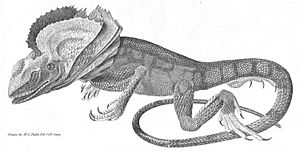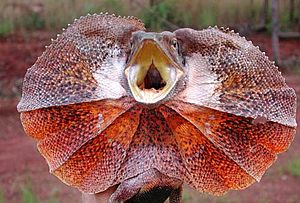Frilled lizard facts for kids
Quick facts for kids Frilled lizard |
|
|---|---|
 |
|
| Conservation status | |
| Scientific classification | |
| Genus: |
Chlamydosaurus
|
| Species: |
kingii
|
 |
|
| Distribution of Chlamydosaurus kingii | |
The frilled lizard (Chlamydosaurus kingii) is also known as the frillneck lizard or frilled dragon. It is a type of lizard from the Agamidae family. These lizards live in northern Australia and southern New Guinea. The frilled lizard is the only animal in its group, called Chlamydosaurus.
Its name comes from the large frill around its neck. This frill usually stays folded against the lizard's body. Frilled lizards can grow up to 90 cm (35 in) long from head to tail. They can weigh up to 600 g (1.3 lb). Male frilled lizards are bigger and stronger than females. Their bodies are usually grey, brown, orangish-brown, or black. The frills can be red, orange, yellow, or white.
Frilled lizards spend most of their time in trees. They mainly eat insects and other small creatures. They are more active during the wet season, when they spend more time on the ground. During the dry season, they stay higher in the trees to find shade. They lay eggs in the late dry season and early wet season. The frill helps them scare away animals that want to eat them. It also helps them communicate with other frilled lizards. Scientists believe this species is not currently in danger.
Contents
Frilled Lizard Classification
A British zoologist named John Edward Gray first described the frilled lizard in 1825. He named it Clamydosaurus kingii. The name Chlamydosaurus comes from ancient Greek words meaning "cloaked" or "mantled" and "lizard". The name kingii honors Captain Phillip Parker King, who led an expedition where the lizard was found. It is the only species in its group.
The frilled lizard belongs to the Agamidae family. Scientists believe it separated from its closest relatives about 10 million years ago. By studying their DNA, scientists have found three main groups of frilled lizards across their range. These groups are separated by rivers and a gap in Australia. Frilled lizards may have moved to southern New Guinea about 17,000 years ago. This was when sea levels were lower, and a land bridge connected the island to Australia.
Here is how the frilled lizard is related to some other lizards:
|
|||||||||||||||||||
What Frilled Lizards Look Like
Frilled lizards can grow to about 90 cm (35 in) long. Their head and body are about 27 cm (11 in) long, and they can weigh up to 600 g (1.3 lb). They have a very large head and a long neck to hold their frill. They also have long legs and a long tail, which makes up most of their length.
Male and female frilled lizards look a bit different. Males are larger and have bigger frills, heads, and jaws. The corners of their eyes are pointed, and their nostrils face downwards. Most of their scales have a ridge down the middle. The scales on their back and sides are a mix of small and large ones.
The frill is a special flap of skin that comes from their head and neck. It has several folded ridges. When fully open, the frill looks like a disc and can be four times wider than the lizard's body. When not in use, it folds neatly around the body. Special bones and cartilage help the frill spread out.
The frill's main job is to scare away predators and to communicate with other lizards. It can also help them blend in when folded. Some scientists think the frill might help them hear sounds better from the front.
Frilled lizards can be grey, brown, orangish-brown, or black on their back. Their underside is usually paler, white, or yellow. Males have a dark belly but a lighter chest. Their sides and underside have dark brown spots that form bands on their tail.
The color of their frills changes depending on where they live. Lizards west of the Ord River have red frills. Those between the river and the Carpentarian Gap have orange frills. Lizards east of the gap have yellow to white frills. Frilled lizards in New Guinea have yellow frills. The brighter frills often have white patches, which might make their display even more impressive.
Their colors come from natural pigments. Lizards with red and orange frills have more of certain pigments. Yellow frills are linked to higher hormone levels. Among western lizards, more red or orange color means more success in fights between males of similar size.
Where Frilled Lizards Live
The frilled lizard lives in northern Australia and southern New Guinea. In Australia, they are found from the Kimberley region in Western Australia, across the Northern Territory, to Queensland's Cape York Peninsula. They also live on nearby islands. In New Guinea, they live in the Trans-Fly grasslands on both the Papua New Guinean and Indonesian sides.
These lizards mostly live in grassy plains and open forests. They prefer higher areas with good soil drainage and many different types of trees, especially Eucalyptus trees. They avoid lower areas with mostly Melaleuca and Pandanus trees. Frilled lizards also like areas with less plants on the ground. This helps them spot prey better from up in the trees.
Frilled Lizard Behaviour
Frilled lizards are active during the day and spend most of their time in trees. They spend over 90% of each day up high. They try to spend as little time as possible on the ground. They only come down to eat, interact with other lizards, or move to a new tree. Male lizards move around more than females.
Males will show off their frills to mark their territory. Frilled lizards can run on two legs, especially when hunting or escaping from danger. To stay balanced, they lean their heads far back.
These lizards are more active during the wet season. During this time, they choose smaller trees and are often seen closer to the ground. In the dry season, they use larger trees and stay higher up. Frilled lizards do not go into a deep sleep during the dry season. However, they can greatly reduce how much energy they use when there is less food and water. Their body temperatures can reach about 40°C (104°F).
They warm up in the sun on tree trunks in the morning and late afternoon. In the dry season, they stop warming up at a lower body temperature to save energy and water. When it gets hotter during the day, they climb higher into the trees for shade. Frilled lizards use large trees and termite mounds as safe places during wildfires. After a fire, they choose trees with more continuous branches.
Frilled lizards mostly eat insects and other small creatures. They rarely eat other vertebrates. Termites, ants, and centipedes are common foods. Termites are very important during the dry season, and moth larvae are important during the wet season.
This species is a "sit-and-wait" predator. It watches for prey from a tree. When it sees something, it climbs down and rushes towards it on two legs. Then it gets on all four legs to grab and eat the prey. After eating, it climbs back up a tree.
Frilled lizards can be eaten by birds of prey and larger lizards and snakes. When they feel threatened, they open their frill to look bigger. They also open their mouth wide, puff up, hiss, and lash their tail. The lizard may also run away and hide from danger. Tiny worms can sometimes live inside their stomachs and intestines.
Frilled Lizard Reproduction and Life Cycle
Frilled lizards can breed during the late dry season and early wet season. Male lizards competing for a mate will open their mouths and spread their frills. Fights can happen, where lizards pounce and bite each other's heads.
The female digs a shallow hole to lay her eggs. They can lay several groups of eggs each season. The number of eggs in a group can be from four to over 20. The eggs hatch after two to four months. Milder temperatures usually produce more males, while very hot or cold temperatures produce more females. Baby lizards have smaller frills than adult lizards.
Lizards grow during the wet season when there is more food. Males grow faster than females. Young males also move further away from where they hatched. Frilled lizards can start having babies when they are about two years old. Males live up to six years, while females live up to four years.
Frilled Lizard Conservation
The International Union for Conservation of Nature says the frilled lizard is not currently in danger. This is because there are many of them, and they live in a wide area. However, they warn that their numbers might be going down in some local areas.
Frilled lizards are popular as pets. This can be a threat to some wild groups. Most pet lizards seem to come from Indonesia, as it is against the law to export them from Australia and Papua New Guinea. It is hard to breed them in captivity. So, many lizards thought to be bred in captivity were likely taken from the wild. Frilled lizards may also be threatened by wild cats. However, they do not seem to be greatly affected by the invasive cane toad.
Frilled Lizards and Humans

The frilled lizard is one of Australia's most famous animals, like the kangaroo and koala. Old evidence shows that some native peoples ate frilled lizards a long time ago. In the late 1800s, a live frilled lizard was brought to England. Another one was kept in a reptile display in Paris. This was when keeping reptiles as pets became more popular.
Because of its unique look and actions, the frilled lizard has often been shown in movies and other media. In Steven Spielberg's 1993 movie Jurassic Park, the dinosaur Dilophosaurus was shown with a similar neck frill that opened when it attacked. The frilled lizard has also been featured on some Australian coins.
See also
 In Spanish: Clamidosaurio de King para niños
In Spanish: Clamidosaurio de King para niños






